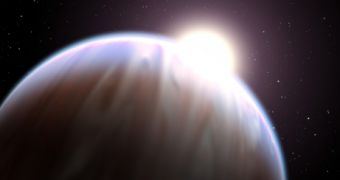Another exo-planet found and yet another intriguing discovery! Astronomers reveal that an exo-planet detected back in 2005, located in a solar system in the Vulpecula constellation, 63 light-years away from Earth, has a methane-rich atmosphere. The planet dubbed HD 189733b is a gas giant relatively similar to Jupiter, orbiting its star from a close distance.
Just last year, with the help of the Spitzer Space Telescope, astronomers were able to detect water on the remote planet. Alternatively, the Hubble Space Telescope confirmed the detection made by the Spitzer Infrared Observatory, but also detected the presence of methane gas in the planet's atmosphere. Because exo-planets are usually too far away to be directly observed with space telescopes, the method used to study their chemical compositions involves spectrometric techniques.
Spectroscopy, uses light emitted from the star and filtered through the planet's atmosphere. Because chemical elements and substances absorb light in certain bands of the light spectrum, these investigations are extremely accurate in establishing what types of chemicals are contained and in what proportion. According to leader of the study Mark Swain from NASA's Jet Propulsion Laboratory, the detection of methane molecules in this exo-planet is the first confirming the prediction that organic substances are also found on other planets throughout the universe.
HD 189733b's orbit around its star allows it to regularly pass in front of it, thus determining a partial eclipse from our perspective. Aside studying the planet's size, mass and other properties, this enables astronomers to study its atmosphere.
Methane and water vapors were confirmed to be present, but carbon monoxide seems to be missing, although all evidence pointed that it should be found somewhere in the upper layers of the atmosphere. Both substances are crucial for the formation of complex organic substances and appearance of life, albeit considering the nature of HD 189733b and its temperature, it is highly unlikely that life will ever originate on it, at least in the form we expect it to be.
All the gas giants in our solar system are believed to have relatively high concentrations of methane in their atmosphere. Their moons are no exception. For example, Saturn's moon Titan contains enough methane gas on its surface to generate power for the whole Earth for up to 1,000 years or more.
Adam Showman from the University of Arizona writes that "When transiting terrestrial planets are detected in the future, this same type of method could potentially be used to infer the composition of the atmospheres of those planets. Since life can alter the chemistry of an atmosphere, this would be a powerful way of searching for evidence of life."

 14 DAY TRIAL //
14 DAY TRIAL //